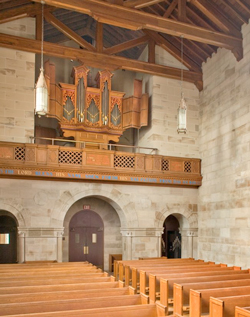by Zoë Madonna, guest contributor

Programs were not distributed. Ramsay let the tiny audience know from the organ loft that titles also might not be announced, before launching into Michelangelo Rossi’s Toccata VII, a 17th century piece for organ as chromatic and dissonant as anything ever aspired to by a modernist. He played as fluidly and freely as if he were improvising it all. Finney Chapel’s much larger pipe organ has the power to shake the stage, but Ramsay proved that Fairchild Chapel’s German Baroque replica could transport the room to another universe.
The concert’s midpoint was “Pur ti miro,” the final love duet from Monteverdi’s L’incoronazione di Poppea. Two sopranos sang sweetly and rapturously over Ramsay’s harpsichord accompaniment. Even without knowing what the piece was, there was no ambiguity about the utter happiness of the text and music.
That midpoint would have also been the high point, had Ramsay not catapulted the music into the present day with his own composition, Half-draw. A low bass note sounded for an instant before a massive cluster lit up the air all at once, the vibrations going straight to the pews below. The piece was composed for the Fairchild organ, which is tuned in mean-tone temperament with split sharps. In layman’s terms: on a regular keyboard, A-sharp and B-flat share the same key, but in this case, they are two slightly different pitches played with different keys, and the same goes for many of the other “black keys.” (“Half-draw” refers to the possibility in a mechanical-action organ of drawing the stop knobs somewhere between on and off, producing microtones.) The chords shimmered, and the sound cycled about the room like an air raid siren from an icy planet. Out of an instrument built to sound old, Ramsay conjured something entirely new and thrilling.
The finale, Terry Riley’s In C in Baroque tuning, was announced as a joking poke at the administration for leaving HP instruments out of the recent “open” performance of the piece in celebration of the fiftieth anniversary of the Conservatory building (their instruments play at a different pitch from modern ones). Fortunately, the deep resonances of the chapel and the rich tones of the instruments couldn’t have made the music sound sour if they tried. However, most of the musicians in the pickup ensemble created for the piece played as ensembles of one, not looking at each other or paying any mind to where their companions were in the sequence of miniature ideas that makes up the piece.ddd
Tenth Muse’s website says that they “invite listeners to be immersed into a cohesive musical experience.” This concert was certainly an experience, and everyone was certainly immersed. Greater cohesion will hopefully come later. For now, if Tenth Muse wishes to accomplish its goal of shaking things up, they’re on the right track. Do them (and yourself) a favor, fill one of those empty seats next semester, and let your brain expand. If they continue like this, those seats won’t be empty for long.
In November, Madonna, a fourth-year Oberlin student, won the 2014 Rubin Institute for Music Criticism prize in San Francisco.
Published on ClevelandClassical.com December 4, 2014 (later revised).
Click here for a printable copy of this article




